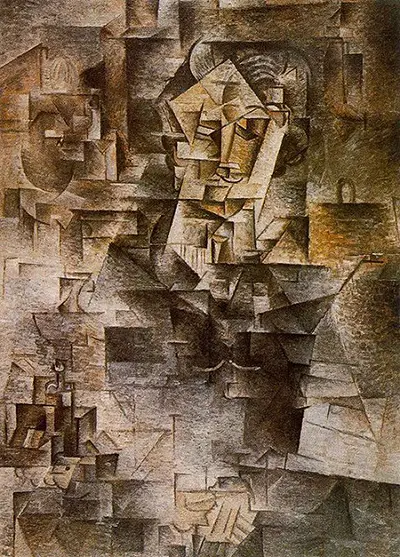He created this portrait in 1910 featuring the analytical cubism style. The artwork is currently held at the Art Institute of Chicago.
Pablo Picasso drew this portrait to commemorate a German art dealer, writer, and publisher called Daniel-Henry Kahnweiler. Daniel played a major role in publicizing Picasso’s works. The character of the portrait launched an art gallery in Paris in 1907 where Picasso displayed his artwork as from 1908.
Daniel-Henry was a big fan of Pablo Picasso works at the time when he experimented with cubism. He would purchase most of the paintings particularly, those created between 1908 and 1915. His book, The Rise of Cubism, provided people with an insight into the theoretical blueprint of the cubism movement. Pablo’s interaction with the German also led him to make a debut into the Parisian art market.
Picasso worked closely with Daniel, and upon completing his portrait, he received a contract that gave him financial security in his career until the onset of the First World War. The Portrait of Daniel-Henry Kahnweiler represents an incursion into the break-up form of an image until the character can barely be discerned. You can only notice Kahnweiler’ face at the point where the mustache begins in the top right of the portrait. The mustache is merely a wave of hairline of slightly darker paint shade.
In the mid-lower section of the image, two lines of paint can be seen which represent Daniel’s watch chain. At the bottom center, the outline of his clasped hands is explicitly displayed in a brown-orange paint. An intriguing African mask has also been added on the top left of the portrait but requires a closer look to be noticed. From this painting onwards, Pablo Picasso rapidly developed a new experimental yet challenging art form that would later revolutionize cubism.
Pablo Picasso impacted the course of the 20th-century art by pioneering artistic movements of Surrealism, neoclassicism, and expressionism. These styles cleverly fuse Iberian and African art developments explored by the adventurous artist in the course of his career. He attempted to harness the aspects of a three-dimensional space and two-dimensional picture plane simultaneously through cubism. This might have inspired his masterpiece portrait of Kahweiler.
Most artists have often been torn between painting the superficial face of a character or depicting what lies beneath the skin. Pablo Picasso leveraged his talent into creating a style that would fulfill this need. It has been embraced by most artists of the modern world who appreciate Picasso’s efforts to identify and exploit unique artistic styles.
Another painting that uses the same style of Kahnweiler’s portrait is Guernica which was drawn in 1937. It featured violent characters and was used as an anti-war art in response to the Spanish Civil War. Picasso, therefore, proves that paintings do not only play an ornamental role but can also be used as weapons against negative forces in the society.
The Portrait of Daniel-Kahnweiler was given to Art Institute of Chicago by Mrs. Gilbert Chapman in remembrance of Charles Goodspeed in 1948. The portrait has been well-received in the world of modern art. Enthusiasts of art such as Jonathan Jones of the Guardian refer to it as one of the biggest artworks currently on exhibition in London. It gives a whole new meaning to a portrait and goes beyond what most people have perceived it to be in the past two centuries.


